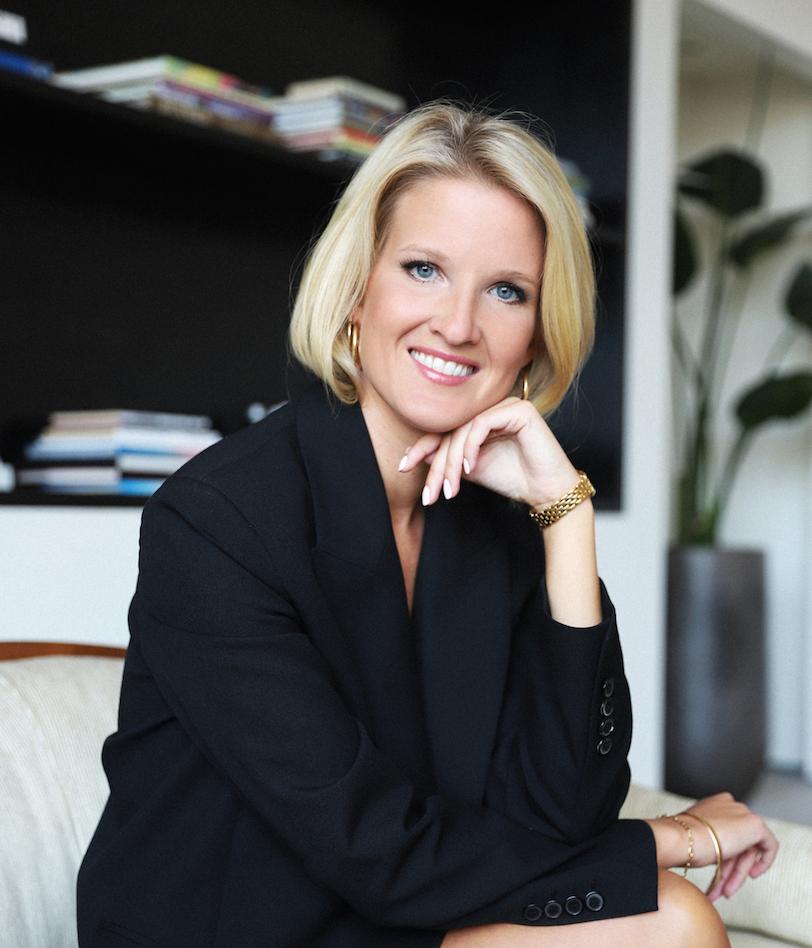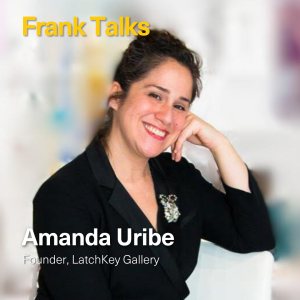Swedish native Emilia Börjesson is the founder of Placemeant, an art and brand consultancy that operates at the intersection between art, culture, and brands. They specialize in helping artists reach their audiences through positioning, brand building, art dealing and full-service representation, all with a social-first digital approach, something Emilia is uniquely positioned to do, with her background in, fashion, marketing and PR, working with Carine Roitfeld and trend forecaster Li Edelkoort, to name a few. Based in New York, Emilia and Placemeant represent artists located in New York, Los Angeles, Paris, and Sweden, and consult both private and commercial clients worldwide. Prior to moving to New York to pursue studies at Parsons, Emilia lived and worked in Sweden, Hong Kong and London.
What was your first job in the Arts?
Technically, Placemeant is my first professional endeavor into the world of arts but I’ve always been involved in it, one way or the other, whether through projects or clients. Starting Placemeant was just an inevitable next step—to make my relationship with the industry official, if you will.
What was the most useful or important thing you learned at that job?
The one thing I learned fast when starting Placemeant is – “if there is a will there is always a way”. Like in any business there are always ups and downs, but I strongly believe that failures are there to point us in the right direction, you just have to keep going.
Tell us a little more about yourself. When did you realize you wanted to pursue a career in this industry?
I grew up going to museums, galleries, and watching all kinds of art movies which quickly became a world that I felt that I needed to constantly be in touch with. Years later, when creating Placemeant, I realized that art was not just an interest, but my calling. From that moment, my determination and passion to pursue a career in the art industry began to evolve very organically. While consulting with brands I saw that artists today also need help to grow, sell and market themselves in innovative ways. It is not just about traditional gallery representation anymore, the evolution of the digital era offers a great opportunity to the current generation to reinvent and implement new ways of selling, create visibility and raise awareness around themselves as artists and their work. There is a new audience that don’t necessarily go to art fairs or galleries. Instead, they purchase art through Instagram, other digital platforms and word of mouth. This market is rapidly growing and I was drawn to the business opportunity I saw in dealing art and creating awareness targeting this new generation of buyers.
What do you do now?
I run Placemeant, the art and brand consultancy I founded in 2016. We operate at the intersection between art, culture, and brands, specializing in helping artists reach their audiences through positioning, brand building, art dealing and full-service representation, all with a social-first digital approach. Through strategic “placemeants”, we connect the dots for emerging and established artists through meaningful partnerships, collaborations, content development as well as physical and digital experiences. We also help art collectors, brands, and businesses through our services in curation, positioning, art advising and brand consulting.
Where are you from?
Gothenburg, Sweden.
Has where you come from shaped what you do in the arts today?
Absolutely. Europe has such an incredible history of art and cultural offering with museums, architecture, and galleries. Growing up visiting these various places and institutions laid the foundation for my connection to art and still inspires me to this day. But my 14 years of living in New York has very much shaped what I do as well — the city has always been a hub for art and artists and it continued to fuel my passion when I left Europe to come here and pursue studies at Parsons.
What is one of the greatest accomplishments in your career so far?
To start my own business in NYC.
What has been a challenge for you?
Sometimes, running a business on your own can be exhausting and, frankly, quite lonely. Thankfully I have a great network that I can rely on for advice and support. I have learned that even a one-woman show needs to ask for help every once in a while.
What is something you do every day at the office (or your current home office)?
For me, the biggest challenge with the home office is missing out on everyday human interactions with my peers and the monotonous nature of being in the same space literally from dawn to dusk. I’ve been adamant about going out for lunch every day so that I get a change of scenery and a chance to clear my mind. And if I can get someone to join me for lunch, even better.
What do you think defines a good employee? And what defines a good boss?
You have to be hungry, have a passion for the job, and not be afraid to speak up. And no ego or prestige please – this gets more and more important the smaller the organization is. A good boss trusts their people, gives them freedom with responsibility and is not afraid to delegate tasks. If you find yourself having to micromanage you need to ask yourself whether the task is wrong, the people you hired are wrong or if you’re simply just not good at explaining things. A good boss functions more like a mentor and inspirator than a task manager. Your job is to keep track of the vision and help others see it too.
What do you think makes a person hirable?
Above all, I think you need to have the potential to grow. Experience can be accumulated and talent can be refined, but ultimately, if there’s no room or interest to grow, what’s the point? Hiring people is always a gamble since it’s virtually impossible to know who they are and how you’ll work together until you’ve seen each other in action, but if the attitude is right, your chances to succeed are a lot better.
What is your advice to making yourself stand out in your workplace? Any good tips for a giving a great interview?
I always thought the best people I ever worked with were the nicest people. People who are generous and happy to share their knowledge, perspective and experience. In an interview, I’d say the most important things to think about are: Be yourself, listen more than you speak, do your research and come prepared with questions, and always consider your audience and what they’re looking for.
Is there any advice you would like to give people entering the art world?
The international art world is basically run on relationships so it is important to build your network and constantly connect with people from all facets of the industry. Also, the art and cultural fields are changing fast, and those who can move skillfully and intelligently across many different areas and practices will have an advantage; don’t limit yourself in your services and keep yourself up to speed on the latest. But most importantly, always be open-minded and go with your heart and gut feeling. And since this world can be intimidating at first, you need to focus on and remind yourself of your strengths and interests and build your career from there. The quickest ticket to success is loving what you do.
What is the best exhibition you have seen in the last year?
I have seen many great exhibitions in the last year actually but to name a few, Miami’s newest interactive art experience, ‘Super Blue’ and next door the great Rubell Museum collection, now including one of my favorite artists at the moment, Amoako Boafo. He was their artist-in-residence during fall 2019 when all the works currently exhibited were created. The ‘Open Storage’ exhibition at The Bass, also in Miami. Gerald Lovell’s first solo exhibition ‘All that I have’ at Pow gallery and Chloe Wise exhibition ‘Thank you for the nice fire’ at Almine Rech Gallery.
What artwork is in your home office?
I currently have artwork from Jessalyn Brooks, Hedi Lanino and Hermentaire among others.
What is/was your greatest WFH challenge? Or a WFH luxury you don’t want to lose ever again?
The biggest WFH challenge was to find focus and concentrate while working from home—to balance the distraction of a million other “to dos” in the house with work tasks and meetings. And honestly, the luxury was to stay in your PJ pants all day – business on the top, quarantine on the bottom. I think many people can relate to that.
How do you think art can play a fundamental role in the world’s recovery from Covid19?
I think art has played a fundamental role throughout the pandemic and continues throughout the world’s recovery and healing. The creative connections to art that so many have shared through social media during the quarantine have shown us that creative expression is a fundamental need for humans. Art nurtures the spirit and calms the mind. That’s why I think rebuilding the creative and cultural spheres as fast as possible is going to be crucial for our collective recovery.
How do you think art should be shared and/or experienced moving forward?
I think we’ve only seen the beginning of how the digital aspects of our world will evolve, how art is being created, presented, experienced and owned. And at the same time, I think we will soon see a counter-reaction: more focus will be put on physical experiences and connections between humans (facilitated by digital tools, but brought to life in the real world).
What is your go-to snack these days? And your go-to soundtrack?
I don’t really snack, I go for a big lunch instead. My go-to soundtrack is my ‘2017 Chill’ playlist on Spotify, 24h of curated songs since 2017 that I love.
If you could own a work by 5 different artists, who would be in your collection?
Oh wow. It is hard to choose only 5 but I would say, Amoako Boafo, Chloe Wise, Cassi Namoda, Gerald Lovell and Henry Taylor.
Since we have been exploring more exhibitions, galleries and museums online, when you start making plans for your next trip – what will be your first art-filled destination? Art destination bucket list?
I have many destinations on my list but Naoshima in Japan, Chinati foundation by Donald Judd in Marfa, Texas and Mexico City is at the top of it.
It can be argued that the art world has finally been forced to adopt and adapt technologies that have long been a part of other industries. Agree or Disagree?
I completely agree. The pandemic has truly been a reset in the art world in many ways and has accelerated this much-needed change. It’ll be interesting to see how we continue this transformation in the next couple of years now that a lot of the bigger, established galleries and museums have been forced to take their businesses and catalogs online.
And finally, do you think the art world should be more transparent?
Yes, and I think the pandemic has established more transparency in the market already. I believe technology and digital tools will continue to contribute to making the industry more transparent, equal, fair, and diverse.




